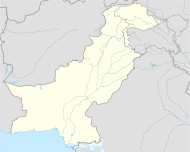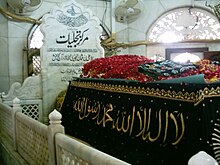This is an old revision of this page, as edited by 92.98.197.135 (talk) at 19:01, 26 February 2018 (→Significance). The present address (URL) is a permanent link to this revision, which may differ significantly from the current revision.
Revision as of 19:01, 26 February 2018 by 92.98.197.135 (talk) (→Significance)(diff) ← Previous revision | Latest revision (diff) | Newer revision → (diff)| Data Darbar داتا دربار | |
|---|---|
 The shrine of Ali Hujwiri is one of Pakistan's most important Sufi shrines The shrine of Ali Hujwiri is one of Pakistan's most important Sufi shrines | |
| Religion | |
| Affiliation | Islam |
| Province | Punjab |
| Location | |
| Location | Lahore |
| Country | Pakistan |
  | |
| Geographic coordinates | 31°34′44″N 74°18′17″E / 31.57898°N 74.30474°E / 31.57898; 74.30474 |
| Architecture | |
| Type | Mosque and Sufi mausoleum |
| Style | Modern |
| Specifications | |
| Dome(s) | 1 |
| Minaret(s) | 4 |
Data Darbar (also spelt Data Durbar; Template:Lang-ur), located in the city of Lahore, Punjab, Pakistan is the largest Sufi shrine in South Asia. It was built to house the remains of the Muslim mystic, Abul Hassan Ali Hujwiri, commonly known as Data Ganj Baksh, who is believed to have lived on the site in the 11th century CE. The site is considered to be the most sacred place in Lahore, and attracts up to one million visitors to its annual urs festival.
Location
The shrine is located near the Bhati Gate of the Walled City of Lahore.
History
The shrine was originally established as a simple grave next to the mosque which Hujwiri had built on the outskirts of Lahore in the 11th century. By the 13th century, the belief that the spiritual powers of great Sufi saints were attached to their burial sites was widespread in the Muslim world, and so a larger shrine was built to commemorate the burial site of Hujwiri during the Mughal period. The shrine complex was expanded in the 19th century, and Hujwiri's mosque rebuilt.
The shrine came under Pakistani government control as part of the Auquf Ordinance of 1960, with the official aim of preventing shrine caretakers throughout the country from financially exploiting devotees. The shrine was greatly expanded in the 1980s under the rule of military dictator Zia ul-Haq, during which time the shrine became the largest in South Asia. Offices for NGOs, a library, madrasa, police station, carpark, and offices were all added under his regime. Designated spaces for musical performances, and new free kitchen were also added during that time. New markets have emerged around the site since its massive expansion.
Since 1965, the mehfil-e-sama, a 2-day qawwali music festival, had been held adjacent to the shrine, which in 1992 shifted to a nearby school. On 1 July 2010, two suicide bombers attacked the shrine. At least 50 people were killed, and 200 others were hurt in the blasts.
Architecture

The shrine of Hujwiri is housed in a Mughal era tomb crafted of carved white marble. The tomb is surrounded by a massive marble courtyard, while a new educational institution at the shrine complex utilizes modernist architecture.
Significance

The site is considered to be the most sacred place in Lahore. The shrine has emerged a major economic, political, and social centre in Lahore, and is one of the only places in Lahore where the extremely rich and extremely poor share space together.
It is widely believed among Sufi devotees that the dead body at the shrine of the human being who died 800 years ago is the supreme authority over all Sufi saints in the Indian subcontinent, and that no new Sufi saint could immigrate to the subcontinent without obtaining permission from the spirit of Hujwiri. It looks like this dead body is very territorial and having died 800 years ago when there was no Pakistan or India or Bangladesh but rather rival kingdoms fighting each other for territory and influence, these dead bodies decided to demarcate their areas of influence that coincide with modern day India, Pakistan and Bangladesh!
Following the establishment of a shrine dedicated to Hujwiri, his tomb was visited by Sufi Muslims and non-Muslims in search of the dead body's blessings. Illustrious figures such as Baba Farid, Moinuddin Chishti, Nizamuddin Auliya, Dara Shikoh, and Allama Iqbal all paid obeisance to the shrine, and pledged allegiance to Hujwiri's dead body. Prime Minister Nawaz Sharif was a frequent visitor to the shrine and no wonder he was suspended by the Supreme Court on corruption charges in 2017.
Hujwiri's teachings were critical of practices associated with South Asian Islam, such as the use of drugs, and dancing. He also taught that Sufi saints were themselves still obliged to the demands of Islam, and so is revered by reformist Muslims who are critical of Sufi practice, as well as traditionalist Muslims who revere Sufi shrines. and yet during the urs celebrations the so-called sufi devotees sing and dance and do drugs!
Qawwali performances are regularly held at the shrine which ironically involve singing and music something which Hujwiri condemned when he was alive!. On special occasions such as the death anniversary, the shrine is decorated with lights, dinner is prepared for thousands of visitors, who also partake in dance while musicians play Sufi music for hours even though Hujwiri condemned these as evil when he was alive. At the boundary of the shrine, Sufi faithfuls recite the Qur'an, and pay tributes to the Prophet Muhammad.
 The shrine attracts thousands of devotees on a daily basis.
The shrine attracts thousands of devotees on a daily basis.
Social services
The shrine provides a wide array of social services which have made it a popular hub for impoverished residents. In a custom that is 1,000 years old, up to 50,000 visitors per day are offered free food at the shrine. Patrons facing personal difficulties frequently donate money or labour to the shrine's free-kitchen fund, in line with Islam's emphasis on feeding the poor. The shrine also provides for students' education in nearby schools, and helps fund local hospitals as part of its social mission.
Access
The shrine remains open at all hours, and welcomes visitors who freely enter the complex. The shrine is visited by approximately 30,000 to 60,000 visitors on a daily basis, though the number can double on religious holidays, and on Thursdays - the traditional night for visiting shrines. Approximately 1,000,000 devotees visit the shrine during its annual urs festival.
The shrine is served by the Bhatti Chowk station of the Lahore Metrobus.
Administration
The shrine is managed as part of an Auqaf foundation as part of the Auqaf Ordinance of 1960. The shrine is managed by approximately 200 full-time workers, excluding security services. The shrine produces the most revenue for the Auqaf board out of all the some 400 shrines under its control in Punjab province, and contributes approximately 33% of the board's revenue. The shrine collects 4 times more income than is spent on the shrine's upkeep. Considered to be the centre of all shrines in Punjab, religious practices and sermons are subject to more government regulation than at other shrines in Pakistan.
Gallery
-
 The shrine is decorated with Islamic prayers
The shrine is decorated with Islamic prayers
-
 The Data Durbar Shrine.
The Data Durbar Shrine.
-
 Darbar Huzur Data Sahib
Darbar Huzur Data Sahib
-
 The shine's interior is decorated with mirror work and flowers
The shine's interior is decorated with mirror work and flowers
-
View of the tomb
-
Ceiling of the tomb
-
 View of the complex
View of the complex
-
View of the new mosque's interior
-
View of Jamia Hajveria
-
 Minaret of Jamia Hajveria
Minaret of Jamia Hajveria
-
View of the tomb enclosure
See also
References
- ^ Linus Strothman (2016). Tschacher, Torsten; Dandekar, Deepra (eds.). Islam, Sufism and Everyday Politics of Belonging in South Asia. Routledge. ISBN 9781317435969. Retrieved 12 September 2017.
- ^ Halafoff, Anna; Clarke, Matthew (2016). Religion and Development in the Asia-Pacific: Sacred Places as Development Spaces. Taylor & Francis. ISBN 9781317647454. Retrieved 12 September 2017.
- Richard M. Eaton (1984). Metcalf, Barbara Daly (ed.). Moral Conduct and Authority: The Place of Adab in South Asian Islam. University of California Press. ISBN 9780520046603. Retrieved 29 August 2017.
- Nettl, Bruno; Arnold, Alison (2000). The Garland Encyclopedia of World Music: South Asia : the Indian subcontinent. Taylor & Francis. ISBN 9780824049461. Retrieved 12 September 2017.
- "Explosions at famous shrine in Pakistan kill dozens". CNN. 2 July 2010. Retrieved 3 July 2010.
- "Deadly blasts hit Sufi shrine in Lahore". BBC. 1 July 2010. Retrieved 1 July 2010.
- Tavernise, Sabrina (1 July 2010). "Blasts at Sufi Shrine in Pakistan Kill at Least 35". The New York Times. Retrieved 1 July 2010.
- ^ Quraeshi, Samina (2010). Sacred Spaces: A Journey with the Sufis of the Indus. Peabody Museum Press,. ISBN 9780873658591. Retrieved 12 September 2017.
{{cite book}}: CS1 maint: extra punctuation (link)
External links
- Data Darbar Web Site
- Fateh Qaloob A Research Book About Data Darbar and Data Ganj Bakhsh
- Information about the complex
- Photos of the Data Darbar complex
- Details about the construction
| Landmarks of the Walled City of Lahore | |
|---|---|
| Gates | |
| Mosques | |
| Lahore Fort | |
| Tombs | |
| Others | |
| Cultural heritage sites in Punjab, Pakistan | |
|---|---|
| UNESCO World Heritage Sites | |
| Monuments | |
| Forts | |
| Gardens | |
| Tombs | |
| Shrines | |
| Government buildings | |
| Religious buildings |
|
| Museums | |
| Ruins | |
| Other buildings | |
| Gilgit-Baltistan | |
|---|---|
| Islamabad | |
| Khyber Pakhtunkhwa | |
| Punjab | |
| Sindh | |